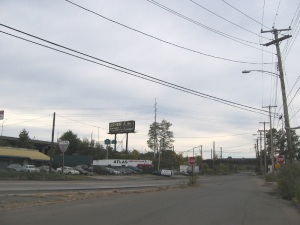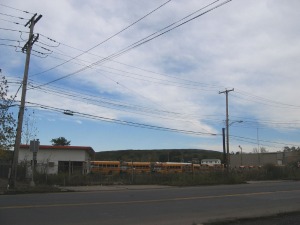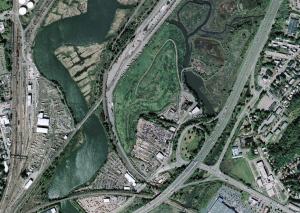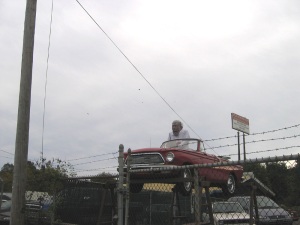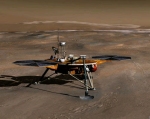It’s Sunday morning, and the cloud cover is thick. A breath of winter blows across low-rent New Haven, rustling up the scraps of trash along the side of the road. I am looking for my garbage—discards tossed between 1983 and 1986, when all of New Haven was a low-rent zone—among the schoolbuses, the weeds, the auto junkers. A couple bundled up in sports jackets and hoodies walk along the road, carrying trash bags and a rake, searching for recyclables hiding in the weeds. Makeshift barriers made out of chunks of broken-down concrete mark the edges of the pavement.
Before I started looking for trash, I never really saw these kinds of places. They’re not part of what we are supposed to see. Rebecca Solnit writes about the national parks—how good we are at looking at the view and not at the parking lot. Garbage is similarly part of a deprecated reality. We don’t see it, even though we ride by it on the freeway. It barely registers even if we travel through it on our way to a visible and visitable place.
But I think there is another dynamic at work, which hinges on the fact that I am a woman. I negotiate my way across public space by reading it, carefully and incessantly. It’s a subconscious activity that continually informs my decisions—to proceed or turn back, stand still or keep going, turn left or right, study the environment or pretend I don’t see a thing—all inspired by “how safe” the landscape reads for a woman by herself. Places like the banks of the Quinnipiac, packed solid with garbage and junk of every other stripe, are marginal. They are a question mark to me. And equally, I am a question mark myself. I’m out of place. Neatly dressed, with a haircut and a full complement of teeth, trim but well-fed, and female—it just doesn’t fit.
Well, here I am. An unnaturally regular, grass-covered hill rises up in the background. I believe I have found my trash.
I have to admire it from a distance, however, because the recycling business that guards the entrance is closed on Sundays. A sturdy gate hangs over the street, warning tresspassers of dire consequences should they proceed. What looks like the back of a car’s bench seat defies the warning, lying lazily and emphatically in the middle of the road. A last blush of red lingers on the naugahyde, which is already declining into the brownish-grey of all disowned objects.
Ironically, I can actually see the dump much better at home, looking at satellite imagery, than feet on the ground. The trash mountain sits in the watery periphery of the Quinnipiac River, hemmed in by rail lines and freeways.
The garbage bump, in the shape of a backward comma or an opening apostrophe, is clearly visible as a slightly brighter green, perhaps because of the overabundance of nutrients in the ground. But much of the surrounding area may also be fill. After all, the original thought behind dumping trash into wetlands was to convert commercially worthless acreage into commercially viable real estate. And given how close this is to the mouth of the river, and how flat the surrounding area, it seems likely that much of what shows in the satellite image was not always solid footing.
In many places, garbage dumps eventually are repurposed. Sports complexes, golf courses, housing developments, pods of office buildings—all of these uses sooner or later take advantage of the reasonable price of not-quite-real estate. But in this place, the economic tides would have to turn very drastically for office buildings to become possible.
At the very least, the freak guarding the entrance to the junk yard would have to disappear. And on balance, I think that might be a loss.
